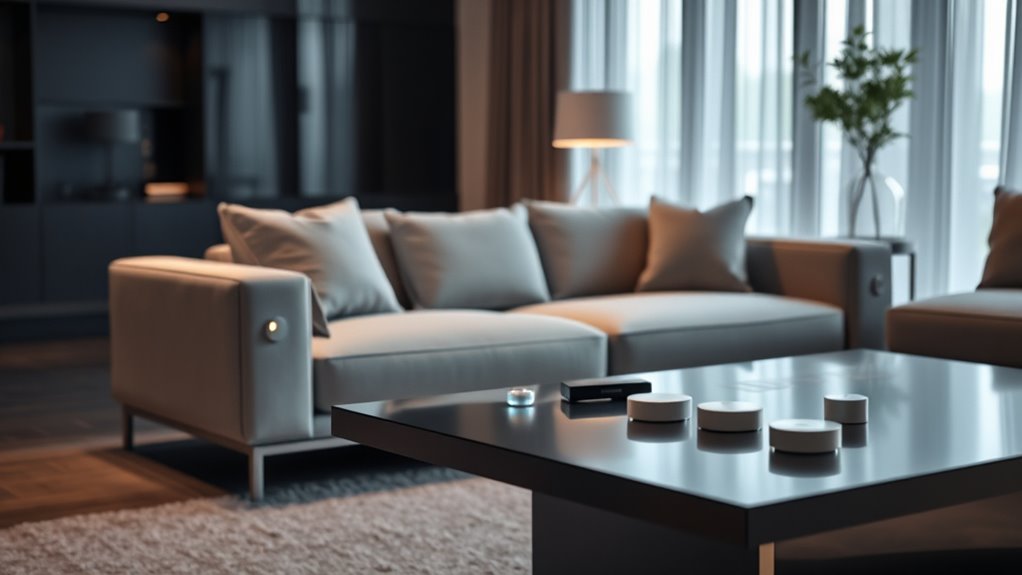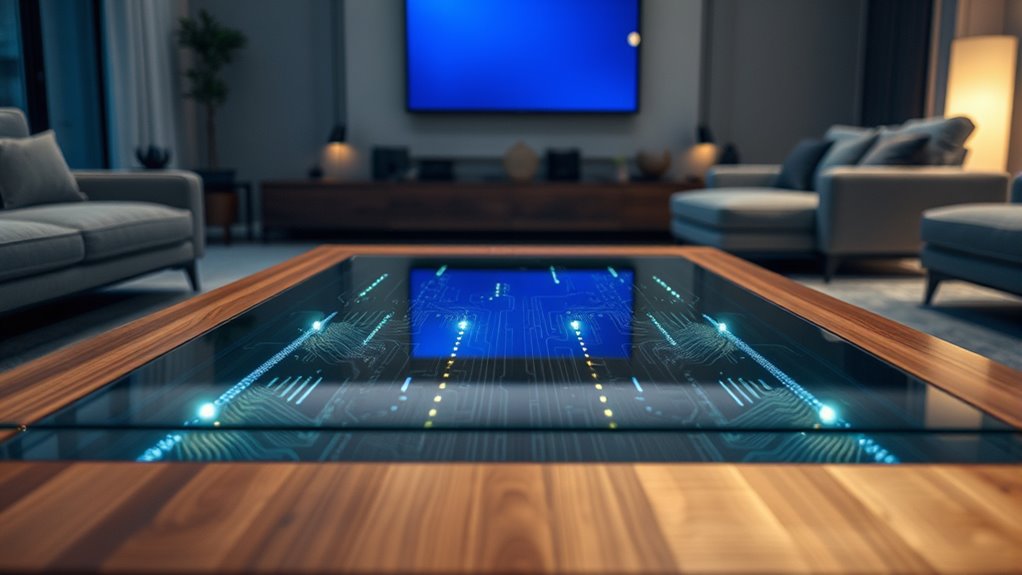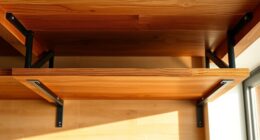Adding sensors to your furniture projects can greatly boost your smart home’s comfort, safety, and efficiency. You’ll want to select high-accuracy sensors and calibrate them regularly to guarantee they respond correctly to environmental changes. Implement proper security protocols to keep your devices safe from unauthorized access. When done right, your smart furniture will respond promptly and reliably. Keep exploring to discover more tips on seamlessly integrating sensors into your home.
Key Takeaways
- Select high-precision sensors suitable for furniture environments to ensure reliable detection.
- Calibrate sensors regularly to maintain accuracy and prevent false triggers in smart furniture.
- Integrate sensors with home automation systems using secure, encrypted connections for data safety.
- Adjust sensitivity settings based on furniture use cases to optimize responsiveness and energy efficiency.
- Follow proper security protocols, including strong passwords and firmware updates, to protect connected sensors.

Smart home integration is transforming the way you manage your household by connecting devices to create a seamless, automated environment. When you add sensors to your furniture projects, you’re taking a step toward smarter living—enhancing comfort, convenience, and safety. But to get the most out of these sensors, you need to pay attention to sensor calibration and security protocols. Proper calibration ensures your sensors respond accurately to environmental changes, like detecting movement or temperature shifts. If they’re not calibrated correctly, you might experience false alarms or missed detections, which can compromise your home’s security or lead to unnecessary energy use. Calibration is a straightforward process: usually, it involves adjusting the sensor’s sensitivity settings or performing a baseline measurement to establish accurate detection parameters. Regular calibration checks help maintain reliability, especially since sensors can drift over time or with environmental variations. Accurate calibration means your smart furniture responds precisely when needed, whether it’s turning on lights, adjusting temperature, or alerting you to movement. Additionally, choosing sensors with high-accuracy, built-in features can further improve the reliability of your smart home system. Security protocols are just as crucial as calibration when integrating sensors into your furniture. Since these sensors often connect to your home network, you must ensure their security to prevent unauthorized access. Strong passwords, encrypted connections, and regular firmware updates form the backbone of effective security protocols. These measures protect your home’s sensitive data and keep malicious actors at bay. Additionally, you should set up authentication procedures for accessing your sensor data and controls, making sure only trusted devices and users can interact with your smart furniture. Think of it as locking the doors and windows of your digital home—adding an extra layer of defense. When deploying sensors, always review the security features offered by your devices and manufacturer. Many come with built-in security options or recommended best practices. Implementing these protocols not only keeps your smart home safe but also preserves your privacy, ensuring that your personal habits and routines stay confidential.
Frequently Asked Questions
What Types of Sensors Are Best for Furniture Projects?
You should choose sensors like pressure sensors for detecting touch or weight, proximity sensors for movement detection, and temperature sensors for climate control. Focus on sensor placement to guarantee accuracy and comfort, placing them where they won’t be obtrusive. Additionally, check sensor compatibility with your existing smart home system to ensure seamless integration. This way, your furniture can become smarter, more responsive, and tailored to your needs.
How Do I Power Sensors in Furniture?
Sure, powering sensors in furniture is easy—just ignore the irony! You’ll want to use wireless power options like inductive charging pads or long-lasting batteries to keep things seamless. Prioritize sensor durability, choosing rugged components that withstand daily wear and tear. This way, your sensors stay powered and functional without the hassle of constant replacements, making your smart furniture both reliable and low-maintenance.
Are Sensor Integrations Safe for Children and Pets?
Sensor integrations can be safe for children and pets if you choose certified, non-toxic components and guarantee proper installation. You should also keep sensors out of reach and regularly check for any damage or loose parts. By prioritizing child safety and pet safety, and following manufacturer guidelines, you minimize risks. Always supervise interactions with smart furniture and consider using sensors with built-in safety features for added peace of mind.
Can Sensors Be Integrated Into Existing Furniture?
You can definitely enhance your furniture by integrating sensors, provided you consider sensor compatibility and furniture material considerations. To do this smoothly, choose sensors compatible with your existing furniture’s structure and material, ensuring they won’t cause damage or interference. With careful planning, you can retrofit your furniture effectively, making your smart home more seamless and functional without the need for complete replacements or extensive modifications.
What Is the Cost Range for Sensor-Enabled Furniture?
The cost for sensor-enabled furniture varies based on sensor installation and furniture compatibility, generally ranging from $200 to $1,000 or more. Basic sensor systems are more affordable, while advanced setups with multiple sensors and smart features cost more. Consider your furniture’s compatibility and the complexity of installation, as these factors influence the overall price. Budget accordingly to make certain of seamless integration and effective smart home functionality.
Conclusion
By adding sensors to your furniture projects, you enhance comfort, increase convenience, and boost security. You create a smarter home where technology adapts to your needs, where safety is prioritized, and where everyday living becomes seamless. Embrace innovation, simplify routines, and elevate your environment. With every sensor, you not only upgrade your space but also unseal new possibilities—making your home smarter, safer, and more personalized. Your future home is waiting—ready for you to make it truly intelligent.









